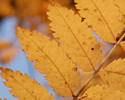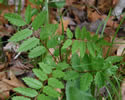Sorbus aucuparia (European Mountain-ash)
| Also known as: | Rowan |
|---|---|
| Genus: | Sorbus |
| Family: | Rosaceae (Rose) |
| Life cycle: | perennial woody |
| Origin: | Europe |
| Habitat: | part shade, sun; urban landscapes |
| Bloom season: | June - July |
| Plant height: | 20 to 40 feet |
| Wetland Indicator Status: | none |
| MN county distribution (click map to enlarge): |  |
| National distribution (click map to enlarge): |  |
Pick an image for a larger view. See the glossary for icon descriptions.
Detailed Information
Flower: 


![[photo of flowers]](/udata/r9ndp23q/pd3/sorbus-aucuparia-17-t.jpg) Flat or rounded cluster to 7 inches across of short-stalked flowers at the tips of 1-year-old branches, blooming when leaves are mature. Flowers are 1/3 to ½ inch across, white with 5 rounded petals. In the center are 2 to 4 short, yellowish styles surrounded by about 20 creamy white, ascending to spreading stamens. The calyx around the base of the flower has 5 short, triangular lobes, and covered in long, silky white hairs. Flower stalks are also covered in, long, soft hairs.
Flat or rounded cluster to 7 inches across of short-stalked flowers at the tips of 1-year-old branches, blooming when leaves are mature. Flowers are 1/3 to ½ inch across, white with 5 rounded petals. In the center are 2 to 4 short, yellowish styles surrounded by about 20 creamy white, ascending to spreading stamens. The calyx around the base of the flower has 5 short, triangular lobes, and covered in long, silky white hairs. Flower stalks are also covered in, long, soft hairs.
Leaves and bark: 

![[photo of leaves]](/udata/r9ndp23q/trees/sorbus-aucuparia-european-mountain-ash_0511_173353-t.jpg) Leaves are alternate, 4 to 9 inches long, compound with 11 to 15 leaflets, occasionally more. Leaflets are oblong-elliptic, 1 to 1½ inches long, ¼ to ¾ inch wide (2.2 to 3.5 times as long as wide), rounded to pointed at the tip, asymmetrical and mostly rounded at the base, and stalkless. Edges are sharply and coarsely single or double-toothed. The upper surface is variably hairy, the lower densely covered in soft hairs. The compound leaf stalk is variably hairy and often reddish. Leaves turn golden yellow to orange-red in fall.
Leaves are alternate, 4 to 9 inches long, compound with 11 to 15 leaflets, occasionally more. Leaflets are oblong-elliptic, 1 to 1½ inches long, ¼ to ¾ inch wide (2.2 to 3.5 times as long as wide), rounded to pointed at the tip, asymmetrical and mostly rounded at the base, and stalkless. Edges are sharply and coarsely single or double-toothed. The upper surface is variably hairy, the lower densely covered in soft hairs. The compound leaf stalk is variably hairy and often reddish. Leaves turn golden yellow to orange-red in fall.
![[photo of twig and buds]](/udata/r9ndp23q/pd3/sorbus-aucuparia-1-t.jpg) Buds are green to dark purple and covered with long, white hairs. New twigs are green to brown and hairy, becoming reddish with scattered, pale lenticels (pores), and hairless the second year.
Buds are green to dark purple and covered with long, white hairs. New twigs are green to brown and hairy, becoming reddish with scattered, pale lenticels (pores), and hairless the second year.
![[photo of mature trunk]](/udata/r9ndp23q/trees/sorbus-aucuparia-european-mountain-ash_1009_154426-t.jpg) Older bark is gray to bronzy, becoming rough with scattered horizontal lenticels, developing plates that eventually peel off. Trunks are single and can reach up to 10 inches diameter at breast height (dbh).
Older bark is gray to bronzy, becoming rough with scattered horizontal lenticels, developing plates that eventually peel off. Trunks are single and can reach up to 10 inches diameter at breast height (dbh).
Fruit: 
![[photo of fruit]](/udata/r9ndp23q/pd3/sorbus-aucuparia-9-t.jpg) Fruit is a cluster of bright orange-red, ¼ to 3/8-inch, round, berry-like pomes (fleshy with a chamber of seeds in the center, like an apple). Fruit matures in late summer and persists through winter.
Fruit is a cluster of bright orange-red, ¼ to 3/8-inch, round, berry-like pomes (fleshy with a chamber of seeds in the center, like an apple). Fruit matures in late summer and persists through winter.
Notes:
European Mountain-ash was once widely planted as an ornamental and has occasionally escaped cultivation, but has gone out of favor in the nursery trade due to its high susceptibility to sun scald, various canker diseases, and bacterial fire blight. Similar to the native American Mountain-ash (Sorbus americana) and Showy Mountain-ash (Sorbus decora), it is most easily distinguished by the hairy leaves, leaf stalks, calyx, and white-hairy winter buds. Leaflets are usually smaller, more coarsely toothed, and less tapering at the tip than both of the natives. The terminal tooth on both natives is typically slender and elongated where the terminal tooth on European Mountain-ash is not much different than the lateral teeth.
Native Plant Nurseries, Restoration and Landscaping Services ↓
More photos
 European Mountain-ash tree
European Mountain-ash tree European Mountain-ash tree
European Mountain-ash tree European Mountain-ash tree
European Mountain-ash tree fall color
fall color seedling emerging with buckthorn in spring
seedling emerging with buckthorn in spring
Photos by K. Chayka taken in Ramsey County. Photos courtesy Peter M. Dziuk taken in various residential landscapes.
Comments
Have you seen this plant in Minnesota, or have any other comments about it?
on: 2017-09-20 11:20:53
Found along side my farm driveway. Volunteer in part shade. Farm located west of Hwy 71 6 miles north of Sauk Centre.
on: 2017-12-28 16:41:38
I will be sent a Rowan tree to be planted this spring. You mention several problems associated with this tree -- what can I do to prevent those issues once I get my tree?
on: 2017-12-28 16:58:53
Donna, we don't provide the kind of information you seek. Ask an arborist, or plant a native mountain ash instead.
on: 2022-12-21 10:14:41
I have one at edge of property in front row of wooded area where it receives the sun. Looks like this tree is much more north than your distribution map.
on: 2022-12-21 18:47:52
Carola, the distribution maps are rarely 100% accurate and don't usually account for non-natives that may have been planted.
on: 2023-06-19 20:28:16
planted "native" mt.ash 25 years ago, flourished. sapsuckers killed. Now many years later, finding Europeans popping up where those used to be. Doing alot of killing/replacing what used to be thought of as natives and widely sold by reputable sources. :(
on: 2023-08-27 16:42:53
We planted this many years ago. Gets flowers but never fruit. Should we cut it down?
on: 2023-08-27 17:08:40
Phyllis, we are not experienced with this, but I would cut it down simply because it is not a native mountain ash. ;)
on: 2024-02-08 22:10:04
Directly off Woodland Avenue on East 5th Street we had ash trees like this. In the fall the grosbeak birds and robins would overeat the red berries- becoming intoxicated. Berries sustained frost and fermentation some nights. Enticing to birds, but dangerous to manage good safety in the colder temps. They often flew intoxicated into windows or dropped from branches and laid on the ground. We retrieved them, brought them inside to warm in a bird cage and re-hydrate overnight. We could nurse the grosbeaks back to health with water from eyedroppers. Robins were more fragile. The birds were returned outside the next morning. These were plentiful trees it seemed in the 60?s -80?s while residing there.






